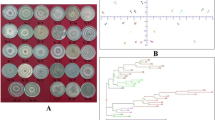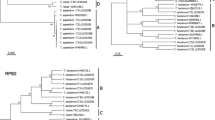Abstract
Monoconidial cultures of 33 isolates of Trichoderma from Buenos Aires Province, Argentina were characterized on the basis of twenty eight morphological, physiological and biochemical features. All of them were screened for proteinase, endochitinase and β-1,3 glucanase activity. Universally primed PCR (UP-PCR) and inter-simple sequence repeat (ISSR) techniques were used to examine the genetic variability among isolates, which resulted in 127 bands for the total number of isolates. These results were subjected to numerical analysis revealing 20 haplotypes grouped in five clusters. The ability of Trichoderma isolates to antogonize soil-borne fungal plant pathogens using a dual culture assay was done against five fungal species: Alternaria sp., Bipolaris sorokiniana, Fusarium graminearum, F. solani, and Pyricularia oryzae. The highest inhibition values (85% RI) were obtained against B. sorokiniana and P. oryzae. Three isolates of T. harzianum named as FCCT2, FCCT3 and FCCT9 were capable of causing a high growth inhibition on four of the fungal species assayed, which was in agreement with their higher extracellular hydrolytic activity. Our results suggest that these isolates have the potential to be effective agents for biocontrol of cereal and tomato fungal pathogens.


Similar content being viewed by others
References
Altschul SF, Madden TL, Schaffer AA, Zhang J, Zhang Z, Miller W, Lipman DJ (1997) Gapped BLAST and PSI-BLAST: a new generation of protein database search programs. Nucleic Acids Res 25:3389–3402
Baek JM, Howell CR, Kenerly CM (1999) The role of extracellular chitinase from Trichoderma virens Gv29–8 in the biocontrol of Rhizoctonia solani. Curr Genet 35:41–50
Becker JO, Schwinn FJ (1993) Control of soil-borne pathogens with living bacteria and fungi: status and outlook. Pest Sci 37:355–363
Bindschedler LV, Sanchez P, Dunn S, Mikan J, Thangavelu M, Clarkson J, Cooper RM (2002) Deletion of the SNP1 trypsin protease from Stagonospora nodorum reveals another major protease expressed during infection. Fungal Genet Biol 38:43–53
Bornet B, Branchard M (2001) Nonanchored inter simple sequence repeat (ISSR) markers: reproducible and specific tools for genome fingerprinting. Plant Mol Biol Rep 19:209–215
Bridge PD (1985) An evaluation of some physiological and biochemical methods as an aid to the characterization of species of Penicillium Subsection Fasciculata. J Gen Microbiol 131:1887–1895
Bulat SA, Lübeck M, Mironenko N, Jensen DF, Lübeck PS (1998) UP-PCR analysis and ITS1 ribotyping of strains of Trichoderma and Gliocladium. Mycol Res 102:933–943
Chaverri P, Castlebury LA, Samuels GJ, Geiser D (2003) Multilocus phylogenetic structure within the Trichoderma harzianum/Hypocrea lixii complex. Mol Phylogenet Evol 27:302–313
Chet I (1987) Trichoderma—application, mode of action and potential as biocontrol agent of soilborne plant pathogenic fungi. In: Chet I (ed) Innovative approaches to plant disease control. Wiley, New York, pp 137–160
Chet I, Chernin L (2002) Biocontrol, microbial agents in soil. In: Bitton G (ed) Encyclopedia of environmental microbiology, vol. 1 NewYork. Wiley, pp 450–465
Consolo VF, Cordo CA, Salerno GL (2008) DNA fingerprint and pathotype diversity of Pyricularia oryzae populations from Argentina. Austr Plant Pathol 37:357–364
Cumagun CJR, Hockenhull J, Lübeck M (2000) Characterization of Trichoderma isolates from Philippine rice fields by UP-PCR and rDNA-ITS1 analysis: identification of UP-PCR markers. J Phytopathol 148:109–115
Dal Bó E, Nome SF, Álvarez S, Colombo MDH, Flores CR (2010) Enfermedades de Solanum lycopersicum L. (tomate). In: Nome SF, Docampo DM, Conci LR (eds) Atlas Fitopatológico Argentino Córdoba, Argentina. URL: http://www.fitopatoatlas.org.ar/
Davet P (1987) Criteres de selection de clones de Trichoderma antagonists de champignons telluriques a sclerotes. EPPO Bull 17:535–540
de la Cruz J, Toro-Pintor JA, Benitez T, Llobell A (1995) Purification and characterization of an endo-beta-1, 6-glucanase from Trichoderma harzianum that is related to its mycoparasitism. J Bacteriol 177:1864–1871
Elad Y, Chet I, Henis Y (1981) A selective medium for improving quantitative isolation of Trichoderma spp. from soil. Phytoparasitica 9:56–67
Elad Y, Chet I, Henis Y (1982) Degradation of plant pathogenic fungi by Trichoderma harzianum. Can J Microbiol 28:719–725
Galich MT (1997) Fusarium head blight in Argentina. In: Duvin HJ, Gilchrist R, Reeves J, McNab A (eds) Fusarium Head Scab: global status and future prospects. Centro Internacional de Mejoramiento de Maíz y Trigo, Mexico, pp 19–28
Ghisalberti EL, Rowland G (1993) Antifungal metabolites from T. harzianum. J Nat Prod 56:1799–1804
Ghisalberti EL, Sivasithamparam K (1991) Antifungal antibiotics produced by Trichoderma spp. Soil Biol Biochem 23:1011–1020
Grondona I, Hermosa MR, Tejada M, Gomis MD, Mateos PF, Bridge PD, Monte E, Garcia-Acha I (1997) Physiological and biochemical characterization of Trichoderma harzianum, a biological control agent against soil borne fungal plant pathogens. Appl Environ Microbiol 63:3189–3198
Harman GE, Howell CR, Viterbo A, Chet I, Lorito M (2004) Trichoderma species-opportunistic, avirulent plant symbionts. Nat Rev Microbiol 2:43–56
Howell CR (2003) Mechanisms employed by Trichoderma species in the biological control of plant diseases: the history and evolution of current concepts. Plant Dis 87:4–10
Kubicek CP, Mach RL, Peterbauer CK, Lorito M (2001) Trichoderma: from genes to biocontrol. J Plant Pathol 83:11–23
Kuhls K, Lieckfeldt E, Börner T (1995) PCR-fingerprinting used for comparison of ex type strains of Trichoderma species deposited in different culture collections. Microb Res 150:363–371
Kullnig C, Mach RL, Lorito M, Kubicek CP (2000) Enzyme diffusion from Trichoderma atroviride (T. harzianum P1) to Rhizoctonia solani is a prerequisite for triggering of Trichoderma ech42 gene expression before mycoparasitic contact. Appl Environ Microbiol 66:2232–2234
Leger RJ, Cooper RM, Charnley AK (1987) Production of cuticle-degrading enzymes by the entomopathogen Metarhizium anisopliae during infection of cuticles from Calliphora vomitoria and Manduca sexta. J Gen Microbiol 133:1371–1382
Leuchtmann A, Petrini O, Samuels GJ (1996) Isozyme subgroups in Trichoderma section Longibrachiatum. Mycologia 88:384–394
Lorito M, Woo SL, Scala F (2004) Le biotecnologie utili alla difesa sostenibile delle piante: i funghi. Agroindustria 3:181–195
Lynch MJ, Slater JH, Bennett JA, Harper SHT (1981) Cellulase activities of some aerobic microorganisms isolates from soil. J Gen Microbiol 127:231–236
Mantel NA (1967) The detection of disease clustering and a generalized regression approach. Cancer Res 27:209–220
Markovic O, Markovic N (1998) Cell cross-contamination in cell cultures: the silent and neglected danger. In Vitro Cell Dev Biol 34:1–8
Mischke S (1996) Evaluation of chromogenic substrates for measurement of protease production by biocontrol strains of Trichoderma. Microbios 87:175–183
Moreno MV, Stenglein SA, Balatti PA, Perelló AE (2008) Pathogenic and molecular variability among isolates of Pyrenophora tritici-repentis, causal agent of tan spot of wheat in Argentina. Eur J Plant Pathol 122:239–252
Murray MG, Thompson WF (1980) Rapid isolation of high molecular weight plant DNA. Nucleic Acid Res 8:4321–4325
Papavizas GC (1985) Trichoderma and Gliocladium: biology, ecology and potential for biocontrol. Annu Rev Phytopathol 23:23–54
Rohlf FJ (1998) NTSYS-PC version 2.0. Numerical taxonomy and multivariate analysis system. Exeter Software: Setauket, NY
Samson RA (1995) Constraints associated with taxonomy of biocontrol fungi. Can J Bot 73:83–88
Samuels GJ, Chaverri P, Farr DF, McCray EB (2009) Trichoderma online, systematic mycology and microbiology laboratory, ARS, USDA. http://nt.ars-grin.gov/taxadescriptions/keys/TrichodermaIndex.cfm (verified Aug 12, 2009)
Seidl V, Seibel C, Kubicek CP, Schmoll M (2009) Sexual development in the industrial workhorse Trichoderma reesei. Proc Natl Acad Sci USA 106:13909–13914
Sharma K, Mishira AK, Misra RS (2009) Morphological, biochemical and molecular characterization of Trichoderma harzianum isolates for their efficacy as biocontrol agents. J Phytopathol 157:51–56
Sivan A, Chet I (1992) Microbial control of plant disease. In: Mitchell R (ed) New concepts in environmental microbiology. Wiley-Liss, New York, pp 335–354
Sivasithamparam K, Ghisalberti EL (1998) Secondary metabolism in Trichoderma and Gliocladium. In: Kubicek CP, Harman GE (eds) Trichoderma and Gliocladium, vol 1. Taylor and Francis, London, pp 139–191
Sneath PHA, Sokal RR (1973) Numerical taxonomy. The principles and practice of numerical classification. WH Freeman, San Francisco, CA
Stasz TE, Nixon K, Harman GE, Weeden NF, Kuter A (1989) Evaluation of phenetic species and phylogenetic relationships in the genus Trichoderma by cladistic analysis of isozyme polymorphism. Mycologia 81:391–403
Stenglein SA, Balatti PA (2006) Genetic diversity of Phaeoisariopsis griseola in Argentina as revealed by pathogenic and molecular markers. Physiol Mol Plant Pathol 68:158–167
Turner D, Kovacs W, Kuhls K, Lieckfeldt E, Peter B, Arsian-Atac I, Strauss J, Samuels GJ, Borner T, Kubicek CP (1997) Biogeography and phenotypic variation in Trichoderma sect. Longibrachiatum and associated Hypocrea species. Mycol Res 101:449–459
Vinale F, D’Ambrosio G, Abadi K, Scala F, Marra R, Turra D, Woo SL, Lorito M (2004) Application of Trichoderma harzianum (T22) and Trichoderma atroviride (P1) as plant growth promoters, and their compatibility with copper oxychloride. J Zhejiang Univ Sci 30:2–8
Viterbo A, Ramot O, Chermin LY, Chet I (2002) Significance of lytic enzymes from Trichoderma spp. in the biocontrol of fungal plant pathogens. Anton Leeuw Int J G 81:549–556
Watts RJ, Chaudhary DK, Tauro P (1988) Isolation and characterization of a new antifungal metabolite of Trichoderma reesei. Plant Soil 107:81–84
White TJ, Bruns T, Lee S, Taylor JW (1990) Amplification and direct sequencing of fungal ribosomal RNA genes for phylogenetics. In: Innis MA, Gelfand DH, Sninsky JJ, White TJ (eds) PCR protocols: a guide to methods and applications. Academic Press, Inc., New York., pp 315–322
Woo SL, Scala F, Ruocco M, Lorito M (2006) The molecular biology of the interactions between Trichoderma spp., phytopathogenic fungi, and plants. Phytopathology 96:181–185
Zimand G, Valinsky L, Elad Y, Chet I, Manualis S (1994) Use of RAPD procedure for the identification of Trichoderma strains. Mycol Res 98:531–534
Acknowledgments
We thank S. Stenglein for help in the collection of samples. Authors V. F. Consolo and G. L. Salerno are career investigators of CONICET (Consejo Nacional de Investigaciones Científicas y Técnicas, Argentina). C. I Mónaco and C. A. Cordo are career investigators of CIC (Prov. Buenos Aires, Argentina). This research was supported by Universidad Nacional de Mar del Plata, CONICET and FIBA.
Author information
Authors and Affiliations
Corresponding author
Rights and permissions
About this article
Cite this article
Consolo, V.F., Mónaco, C.I., Cordo, C.A. et al. Characterization of novel Trichoderma spp. isolates as a search for effective biocontrollers of fungal diseases of economically important crops in Argentina. World J Microbiol Biotechnol 28, 1389–1398 (2012). https://doi.org/10.1007/s11274-011-0938-5
Received:
Accepted:
Published:
Issue Date:
DOI: https://doi.org/10.1007/s11274-011-0938-5




